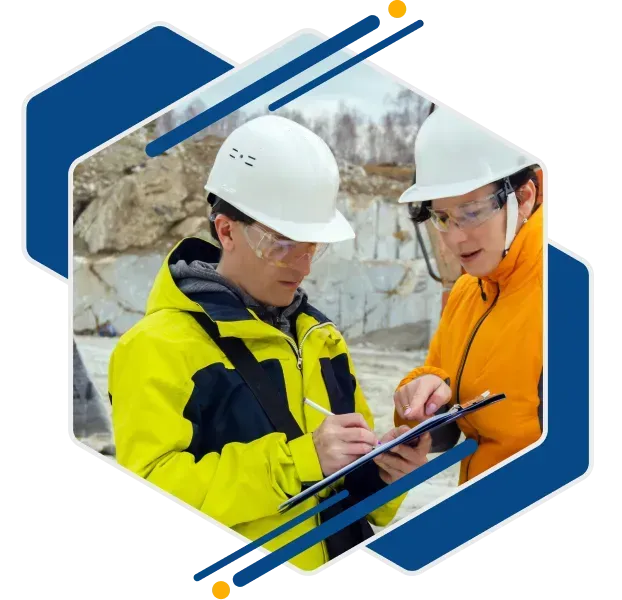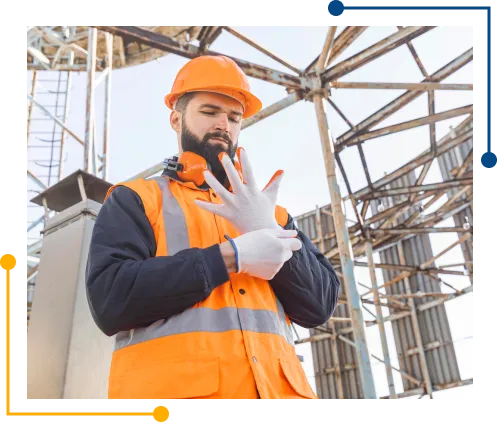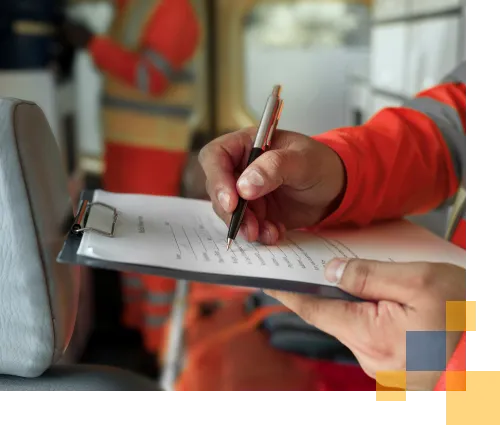Now Offering Spanish Safety Training!

Now Offering Spanish Safety Training!
Construction Safety
Policy Manual Development
FSDAVCFEBFEVSDDVFSD
FSDAVCFEBFEVSDDVFSD
FSDAVCFEBFEVSDDVFSD
Construction Safety - Policy Manual Development
Developing Your Construction Safety Policies

Policy manual development is crucial for enhancing safety on construction sites. These manuals outline specific protocols for addressing job hazards, defining roles, and handling emergencies. By guiding workers on safety measures, they improve compliance and create safer job sites, reducing accident risks.
Tailored to construction-specific challenges, these manuals cover risks like heavy machinery operations, fall protection, and hazardous materials management. Regular updates keep them aligned with current OSHA standards, ensuring effective safety measures. This proactive approach helps minimize compliance gaps, supporting a safer, more organized work environment.

Construction Safety Manuals for Modern Times
Creating clear and detailed policy manuals is critical for maintaining safety on construction sites. These manuals should start with an overview of general safety guidelines, followed by specific procedures addressing unique construction hazards. This structured approach helps workers understand safety measures better and apply them effectively, minimizing risks on job sites.
Incorporating regular safety program development into policy manuals ensures that employees receive training aligned with the documented safety measures. This alignment not only reinforces compliance but also promotes consistency across projects. When safety measures are paired with hands-on training, workers can better grasp and apply safety protocols in real-world scenarios, enhancing overall safety.
Routine evaluations and updates of policy manuals are essential for staying aligned with OSHA regulations and current construction practices. Reviewing the manual periodically allows companies to address changes in protocols, workplace conditions, or any incidents that occur. This continuous improvement approach ensures safety measures remain effective, reduces potential compliance gaps, and fosters a proactive safety culture across the construction industry.
Consistent Policy Application on the Job Sites

Effective policy implementation relies on clear documentation and procedures, helping construction workers understand and apply safety protocols. Establishing a construction safety pre-qualification system helps ensure workers meet safety standards before entering the site. This process not only reinforces safety measures but also keeps compliance consistent across various construction sites. Regular drills and safety meetings support this effort, making safety protocols second nature to employees.
Ongoing communication is essential for successful safety policy adherence on the job site. Encouraging workers to report any hazards or protocol misunderstandings fosters transparency and collaboration throughout the company. Safety manuals should provide detailed guidance on reporting safety issues, reinforcing a proactive approach. When employees understand their roles clearly, they contribute to safer work environments by addressing issues promptly and minimizing risks.

Safety procedures require regular updates to address changing site conditions effectively. By integrating train-the-trainer programs into policy manuals, workers gain essential skills to identify specific hazards like heavy machinery, fall protection, and confined spaces. These targeted updates ensure that safety measures remain relevant, helping employees stay prepared for various risks. This proactive approach not only reinforces compliance but also enhances workers’ confidence, fostering a culture of safety on construction sites.
Effective training combines classroom instruction with hands-on activities, ensuring workers thoroughly understand safety protocols. This mix of learning styles helps employees retain information and apply it accurately on the job. For instance, hands-on training related to equipment handling or fall arrest systems gives workers the practical experience needed to implement safety measures confidently. Consistent practice of these procedures leads to improved protocol adherence, fewer accidents, and better alignment with OSHA standards.
Frequently Asked Questions
Frequently Asked Questions
What exactly is included in a Policy Manual Development service for the construction industry?
Our Policy Manual Development service includes a comprehensive assessment of your construction site's specific safety needs and regulatory requirements, the creation of tailored policies and procedures that address the unique challenges of your worksite, such as fall protection, scaffolding safety, and electrical hazards, and guidance on implementing these policies to comply with OSHA standards. The manual will cover best practices in risk management, safety training, and emergency response procedures, all tailored to the diverse nature of construction work.
How does Nain and Associates customize the Policy Manual to my specific construction project or company?
We begin with an on-site assessment to gain a thorough understanding of your construction activities and identify the unique risks and challenges your workers face. This enables us to craft clear, actionable policies that are directly relevant to your operations. By collaborating closely with your management and safety teams, we ensure the manual reflects your specific safety needs, workplace environment, and complies with industry regulations.
Why is a customized Policy Manual important for my construction business?
A customized Policy Manual is crucial because it addresses the specific risks and safety challenges found in your particular construction environment, which can significantly differ from one project to another. Tailored manuals ensure compliance with OSHA and other relevant safety regulations, reduce the risk of workplace accidents, and foster a culture of safety among your workforce, ultimately protecting your employees and your business.
How often should the Policy Manual be updated, and does Nain and Associates offer support for these updates?
The Policy Manual should be reviewed and updated regularly, at least annually, or whenever significant changes occur in operations, safety regulations, or after an incident that highlights the need for policy adjustment. Nain and Associates offers ongoing support and advisory services to update your Policy Manual, ensuring it evolves with your business and remains compliant with the latest safety standards and regulations.
What are the first steps to get started with Policy Manual Development for my construction company?
The first step is to contact Nain and Associates for an initial consultation. During this meeting, we will discuss your construction company's specific needs, the scope of your operations, and any known safety concerns or compliance challenges you are facing. Following this, we will schedule an on-site assessment to begin the process of developing your customized Policy Manual, tailored to the unique aspects of your construction business and designed to enhance your overall safety and compliance posture.
Effective Safety Manual Implementation Strategies
Establishing a clear implementation process is crucial for effective safety manual use. It starts with distributing manuals to all employees and providing a brief overview of essential safety protocols. This ensures that every team member is aware of their roles in maintaining safety standards across the job site.
For better engagement, safety meetings should regularly reference manual guidelines, reinforcing key safety protocols and their practical application. Incorporating pre-qualification assistance for safety ensures that employees understand and meet necessary safety requirements. This approach helps workers stay prepared for potential risks and enhances job site safety awareness.
Regularly reviewing the effectiveness of safety manuals is vital. Gathering employee feedback helps identify any gaps in understanding or areas for improvement. This ongoing review process keeps manuals updated and relevant, addressing new safety challenges as they arise.


Implementing feedback-based revisions is essential for ensuring that safety protocols remain practical and effective. Regularly updating training materials and manuals based on employee input allows organizations to maintain OSHA compliance and reduce accidents on construction sites. This proactive approach fosters a culture of continuous safety improvement, encouraging employees to engage actively with safety measures. As safety becomes a shared responsibility, it not only enhances workplace safety but also contributes to a more knowledgeable and prepared workforce, resulting in better safety outcomes across projects.
Common Safety Protocols in Construction Policy Manuals
Developing effective safety protocols in construction policy manuals is a critical step toward ensuring compliance and reducing risks on job sites. These manuals serve as a vital resource for guiding workers through daily tasks while maintaining safety standards. Clear, detailed instructions help workers understand their responsibilities, ensuring consistent adherence to safety protocols. Frequent policy reviews also play an important role in reinforcing safe work practices.
To enhance safety manuals, organizations should integrate construction safety pre-qualification assistance, ensuring that guidelines align with pre-qualification standards for contractors and employees. This approach helps identify potential safety gaps before work begins, enabling timely adjustments. The pre-qualification process also supports a safer work environment by setting clear expectations for all team members, from supervisors to workers, about required safety measures and compliance criteria.
Ongoing engagement with workers is essential for maintaining an effective safety culture. Encouraging workers to actively participate in safety meetings and provide feedback fosters a sense of ownership over safety protocols. When employees feel invested in safety outcomes, they are more likely to adhere to established procedures and suggest improvements. This collaborative approach not only ensures compliance with OSHA standards but also contributes to a safer, more proactive workplace culture across all construction projects.
Have Questions About Our Services?
Contact us to learn more today!
Have Questions About Our Services?
Contact us to learn more today!
Design By: Customers.Plus
© 2025 | Nain & Associates LLC




